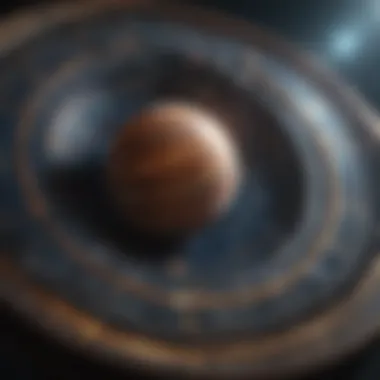Astro Birth Chart Analysis: Unveiling Celestial Influences


Intro
Astro birth chart analysis offers a unique window into the human experience. As each birth chart is exclusive to the moment of an individual’s birth, it holds precise information about their personality traits, potential life events, and the unique blend of influences that can shape their reality. Understanding this chart is not just for the astrological enthusiast; it can enhance personal development and illuminate the nuances of interpersonal relationships.
To embark on this journey, we need to dissect the multiple components of a birth chart. These include the positions of planetary bodies at the time of birth, the aspects they create with each other, and how these factors correlate to zodiac signs. This article aims to provide clarity on these elements, assisting readers in interpreting their own charts and discovering how cosmic pathways impact their lives.
Characteristics of Each Zodiac Sign
Astrology often begins with the zodiac signs. Here, we delve into the core characteristics attached to each sign:
Overview of personality traits
- Aries: Bold, energetic, and competitive.
- Taurus: Reliable, patient, and dedicated.
- Gemini: Versatile, communicative, and curious.
- Cancer: Intuitive, emotional, and protective.
- Leo: Charismatic, ambitious, and generous.
- Virgo: Analytical, meticulous, and service-oriented.
- Libra: Diplomatic, fair-minded, and sociable.
- Scorpio: Passionate, resourceful, and determined.
- Sagittarius: Adventurous, idealistic, and optimistic.
- Capricorn: Disciplined, responsible, and pragmatic.
- Aquarius: Innovative, independent, and forward-thinking.
- Pisces: Compassionate, artistic, and dreamy.
Each zodiac sign is tied to a set of strengths and weaknesses that can influence behavior and life choices. Every sign offers unique qualities that can enrich the lives of those who embody them.
Strengths and weaknesses
- Strengths: These attributes boost an individual's capabilities, enhance resilience, and facilitate growth.
- Weaknesses: Understanding these shortcomings is essential for self-improvement. Recognizing them allows individuals to navigate life's challenges more effectively.
Compatibility with other signs
Astrological compatibility can provide insights into relationships. Each sign interacts differently with others, creating various dynamics. For instance, Fire signs (Aries, Leo, Sagittarius) may resonate well with Air signs (Gemini, Libra, Aquarius), while Water signs (Cancer, Scorpio, Pisces) may find common ground with Earth signs (Taurus, Virgo, Capricorn).
Understanding Birth Charts
Birth charts detail the unique celestial alignment at the time of one’s birth. This section breaks down the key components:
Components of a birth chart
- Sun sign: Reflects the core personality.
- Moon sign: Represents inner emotions and instincts.
- Rising sign (Ascendant): Influences outward behavior and appearance.
- Planetary positions: Each planet signifies different aspects of life, from relationships to career choices.
How to interpret planetary positions
Interpreting where planets reside within the houses of a birth chart provides insights into various life areas. For example, the position of Venus can indicate matters of love and affection.
Impact of zodiac signs on personality
Every sign imparts specific characteristics based on its elemental affiliation and modalities. These elements flavor how each person interacts with the world.
Finale
By understanding the characteristics of each zodiac sign and interpreting birth charts effectively, individuals can access a deeper understanding of themselves. This knowledge not only guides personal development but also enhances understanding of others, enriching interpersonal relationships. Understanding these principles enhances the value of astrology in one’s life.
Prologue to Astro Birth Charts
Astro birth charts, often called natal charts, are essential tools that play a significant role in astrological practice. They offer insight into the unique celestial positioning at the precise moment of an individual's birth, reflecting not just personality traits, but also potential life events and relationships. Understanding astro birth charts is crucial for anyone interested in astrology, as they serve as a foundational map for interpreting astrological influences.
The birth chart is composed of various components, including the planets, zodiac signs, and houses, each contributing its unique energies and characteristics. By studying these elements, one can unlock deeper understanding of oneself and others. This article takes a systematic approach to explore the complexities of astro birth charts, aiming to provide clarity and depth.
Some key benefits of analyzing your astro birth chart include:
- Gaining self-awareness and personal insights.
- Enhancing interpersonal communication through an astrological lens.
- Understanding life tendencies and potential challenges.
By diving deeper into the intricacies of astro birth charts, this article aims to equip readers with the tools to analyze their own charts effectively, enhancing their grasp of personal and relational dynamics.
What is an Astro Birth Chart?


An astro birth chart is essentially a snapshot of the sky at the time of one’s birth. This chart captures the positions of the planets, the sun, and the moon relative to the Earth within the twelve zodiac signs and houses. Each of these elements holds specific meanings that combine to characterize an individual’s personality and life path. It is believed that these celestial arrangements influence core aspects of how a person may think, feel, and behave throughout their lifetime.
Each astro chart is unique, shaped by the exact time and place of birth. Therefore, two individuals born on the same day could still possess entirely different charts due to varying locations and times.
The crux of understanding one’s birth chart lies in recognizing how each component interacts within the chart. The relationships between these elements create layers of complexity, revealing a broader narrative of one’s behavioral patterns and tendencies.
The Historical Context of Astrology
Astrology is an ancient practice that dates back to several millennia. It has been observed in diverse cultures such as the Babylonians, Greeks, and Egyptians. Each of these civilizations contributed to the development of astrology, laying the logical foundations outlined in the concept of celestial bodies influencing earthly events.
Historically, astrology has been understood as a method to interpret human experience and potential. In ancient times, it served practical purposes, such as guiding agricultural practices and predicting significant events in the realms of politics and warfare.
Despite the passage of time, astrology remains relevant. In contemporary society, it has seen a resurgence, as many individuals seek deeper understanding amid chaotic life events. The interest in astro birth charts is part of this revival, with more people turning to them to navigate their personal journeys and enhance their understanding of complex life dynamics.
"Astrology, in its essence, provides a lens through which we can examine ourselves and our relationships with the cosmos."
The relationship with one’s birth chart is personal and intimate. It serves as both a guiding star and a reflective tool, encouraging us to explore the deeper recesses of our individual psyches.
Components of a Birth Chart
Understanding the components of a birth chart is essential for anyone exploring astrology. A birth chart serves as a roadmap of celestial dynamics at the moment of an individual's birth. Each element within the chart carries significant meaning, offering clues to personal traits, life challenges, and potentials. Knowing the components enhances your ability to interpret the complexity of astrological influences effectively.
The Zodiac Signs and Their Significance
The zodiac signs are the foundation of any birth chart. Each sign represents specific characteristics and values. For instance, Aries is often associated with assertiveness and courage, while Pisces embodies intuition and sensitivity. There are twelve zodiac signs in total, and each individual's chart features one or more signs that impact various aspects of their personality and behavior.
Understanding the qualities of zodiac signs helps in recognizing patterns in behavior and emotional responses. It assists in self-identification, allowing individuals to connect better with their strengths and weaknesses. Moreover, astrology enthusiasts can compare different zodiac signs to assess compatibility and social dynamics.
The Twelve Houses of the Chart
The twelve houses in an astrological chart signify different areas of life and personal experiences. Each house corresponds to significant themes such as relationships, communication, and career. For example, the First House represents self-image and identity, while the Tenth House relates to career and public status.
Each house's position and associated signs provide critical insights into one's life journey and challenges. By analyzing the houses, one can gain a clearer understanding of how various aspects of existence interact. It's a key aspect of interpreting birth charts effectively, giving depth to personal traits and life events.
The Planets and Their Influence
Planets in astrology are thought to influence human behavior and experiences. Each planet represents different energies and traits. For example, Venus is known for love and beauty, while Saturn embodies discipline and responsibility. The interactions between planets within a birth chart create unique configurations that further define personality.
The positions of these planets within the houses and signs add another layer of meaning. For instance, if Mars is located in the Fifth House, creativity and passion may be amplified in personal expression. Understanding planetary placements helps individuals to understand motivations and actions in various life areas.
In summary, recognizing the significance of the zodiac signs, houses, and planets is fundamental for a deep comprehension of any birth chart. Each component plays a vital role, driving home the intricacies of astrology and its impact on individuals' lives.
"The birth chart is a complex symphony of astrological influences, each component adding its unique note to the melody of life."
Thorough examination of these elements leads to greater self-awareness and understanding of one's place in the cosmos.
Interpreting Your Birth Chart
Exploring your birth chart is a essential step in understanding astrology and its personal implications. Birth charts, also known as natal charts, provide a unique snapshot of an individual's celestial influences at the moment of birth. Interpreting this chart is much more than a superficial alignment of planets; it requires a deep dive into the symbolic representations and their interactions. Understanding these elements empowers the individual to engage in self-reflection, acknowledge personal traits, and navigate life's challenges with awareness.
Aspects: Angles Between Planets
Aspects refer to the angles formed between planets in a birth chart. These angular relationships play a crucial role in shaping one's experiences and personality traits. In total, there are essential aspects such as conjunctions, squares, trines, and oppositions. Each aspect has its unique influence:
- Conjunctions create a powerful merging of energies, enhancing the traits of the involved planets.
- Squares indicate potential conflict or challenges that encourage growth.
- Trines suggest harmony and ease, facilitating positive outcomes and experiences.
- Oppositions may represent tension but also potential for balance and growth through understanding opposing forces.
Interpreting these aspects enables individuals to comprehend how various planetary influences interact with one another, revealing themes of cooperation or conflict within themselves. Recognizing these dynamics can support more tailored approaches to personal development.
Identifying Dominant Elements


When analyzing a birth chart, determining the dominant elements—earth, air, fire, and water—offers insight into a person's intrinsic qualities. Each element embodies specific characteristics:
- Earth indicates practicality, stability, and a grounded nature. It often manifests in a structured approach to life.
- Air signifies intellect, communication, and social interactions. An air-dominant individual may excel in expressing ideas and connecting with others.
- Fire embodies passion, creativity, and boldness. Those influenced by fire are typically inspired action-takers.
- Water represents emotion, intuition, and empathy. Water-dominant individuals often navigate life through feelings and deep connections.
Identifying which elements dominate one's chart aids in understanding inherent strengths and weaknesses. It highlights personality inclinations, guiding individuals on where they may need to adjust for personal growth.
The Role of Retrogrades in Chart Analysis
Retrogrades occur when planets appear to move backward in the sky from our perspective on Earth. This phenomenon holds significant importance in chart analysis. When a planet is retrograde, its energy is often expressed differently.
- Mercury Retrograde is well-known for communication disruptions. During this time, reflection and reconsideration are advisable rather than initiating new ventures.
- Venus Retrograde may prompt reassessment in relationships or personal values. It's a period to contemplate what matters most in connection to others.
- Mars Retrograde suggests a need to reevaluate actions and motivations. It's usually not the time for new activities but rather for reflection on existing endeavors.
Understanding retrograde influences can significantly aid in personal decision-making. Acknowledging when a planet is retrograde can help approach situations with a renewed perspective, allowing for better results.
"Astrology is a language. If you understand this language, the sky speaks to you."
Dane Rudhyar
Practical Applications of Birth Chart Analysis
Understanding one’s birth chart can be a pivotal tool for personal exploration and development. Practical applications of birth chart analysis highlight how the celestial arrangements influence individual lives, decisions, and interpersonal relationships. This section examines key areas where understanding a birth chart can yield significant benefits.
Personal Growth and Self-Awareness
Astrological insights often serve as a mirror for individuals. By analyzing their birth chart, one can gain a deeper understanding of their inherent strengths, weaknesses, motivations, and challenges. This awareness can foster personal growth, as individuals may be inspired to harness their strengths effectively while working on their weaknesses. Each planetary position and aspect tells a story. For example, someone with a strong Jupiter placement might excel in opportunities, while a difficult Saturn aspect could suggest lessons around responsibility.
"Astrology is not just about predicting the future; it's about understanding yourself and your path."
Such insights can improve self-esteem and lead to more informed life choices. Recognizing personal patterns from astrological analysis may also highlight recurring themes and life lessons—encouraging individuals to embrace change and personal evolution.
Navigating Relationships Through Astrology
Relationships are complex and multi-faceted. Astrology can be a valuable guide for navigating these interactions. By examining synastry and composite charts, individuals can gain clarity about their relationships and how they relate to others. Understanding the astrological influences on a partnership can enhance communication, resolve conflicts, and foster a deeper bond.
Compatibility Analysis
Compatibility analysis examines how the birth charts of two individuals interact. This method highlights aspects, house placements, and planetary influences that indicate potential harmony or discord in relationships. The key characteristic of compatibility analysis lies in its detail-oriented approach toward the interaction between two charts.
Compatibility analysis has become a popular choice among those who seek to understand romantic and platonic relationships. It maps out strengths in a relationship, such as complementary elements and supportive aspects, as well as challenges that might require conscious effort and understanding. A main advantage of this analysis is its ability to provide actionable insights, guiding both parties on how to best interact for a fulfilling relationship. However, over-reliance on compatibility analysis may lead to deterministic views about relationships, neglecting the importance of personal effort and choice.
Synastry and Composite Charts
Synastry and composite charts take relationship analysis a step further. Synastry examines how individuals’ planets interact with one another, promoting an understanding of dynamics and emotional connections. Composite charts blend two charts into one, offering a snapshot of the relationship as a whole.
The critical feature of synastry lies in its ability to highlight challenges and supportive potentials in relationships, providing both partners with valuable insight into their synergy. Composite charts can deepen this understanding by representing how the relationship operates as a unique entity.
Both techniques are beneficial for anyone looking to understand their connections at a deeper level. They can reveal unseen dynamics that influence the relationship, guiding partners through conflict and fostering appreciation for each other's differences. However, it is essential to approach these tools with a nuanced understanding. A single aspect may not define a relationship's fate; rather, it is the totality of interactions that weave the unique tapestry of a partnership.
Exploring the practical applications of birth chart analysis can lead to greater self-awareness and enriched relationships. As individuals engage with their astrological insights, they can embark on a journey toward personal growth and deeper connections with others.
Advanced Techniques in Birth Chart Analysis
Birth chart analysis offers profound insights into one’s personality and life path. However, the field of astrology extends far beyond standard interpretations. Advanced techniques enhance this analysis, allowing astrologers to gain a more nuanced understanding of celestial influences. These methods often emphasize how dynamic astrological factors influence individual experiences over time, offering predictive insights unwound from standard configurations.
Specifically, advanced techniques can help practitioners discern more intricate patterns and cycles affecting their clients or themselves. Understanding these techniques can lead to improved personal growth, relationships, and life decisions, echoing the subtle complexities of existence itself. Thus, mastering these methods can vastly enrich astrological practice.
Transits and Progressions: Predicting Life Events
Transits and progressions are key concepts in astrology that indicate how planetary movements affect a person over time. Transits deal with the current position of planets moving through the zodiac in relation to the natal chart. They help identify specific periods that might be significant for personal developments. Each planet brings its unique energy during these transits, allowing astrologers to predict challenging times or breakthroughs. For instance, a long transit of Saturn can suggest a period of hard work and responsibility, often leading to eventual success.


On the other hand, progressions involve a symbolic approach to understanding cosmic events. A commonly used method is the day-for-a-year technique, where each day after a person’s birth represents a year in their life. Progressed planets show how internal growth evolves, thus providing insight into emotional development and maturity over time.
By analyzing transits and progressions together, astrologers can construct a more comprehensive view of significant life events, revealing patterns that individuals might not notice otherwise. This combined analysis also facilitates a deeper connection to one's journey by illustrating how external factors and inner growth coalesce during different life stages.
Harmonics and Void-of-Course Moons
The study of harmonics in astrology involves interpreting how different planetary positions resonate with each other. This technique utilizes the concept of divisions, or harmonics, to form a more intricate perspective of personal energy. For instance, when analyzing a birth chart through harmonic lenses, one can see how relationships between planets create specific themes or focal points in a person's life. Each harmonic resonates with different aspects like talent, challenges, or relationships, offering insights that are valuable when working on personal development.
Void-of-course moons also provide unique insights in birth chart analysis. This term describes the period when the Moon transitions from its last aspect to the next sign. During this time, it is often suggested that actions taken may lack focus or a clear outcome. Knowing when these periods occur can guide individuals on when to initiate or avoid significant activities.
By utilizing these advanced techniques, astrologers can engage more deeply with the birth chart. They are not just tools for prediction but invite exploration into the fabric of life’s rhythms and personal paths.
"Astrology is not just a mere prediction of the future; it’s a language that speaks of potential, challenges, and everything in between."
In summary, understanding transits, progressions, harmonics, and void-of-course moons provides astrologers and their clients with actionable insights. This nuanced approach crafts a more personalized and profound astrological experience.
Common Misconceptions About Birth Charts
Understanding the common misconceptions surrounding birth charts is crucial for any serious student of astrology. Misinterpretations can lead to confusion and disinterest in the subject, ultimately detracting from its rich and profound insights. Grasping these errors allows for a clearer comprehension of what an astro birth chart truly represents. By addressing these misconceptions, practitioners and new learners alike can navigate the astrological universe more effectively. It helps demystify astrology, enabling individuals to see it as a valuable tool for personal insight rather than a rigid fate.
Astrology vs. Astronomy
Astrology and astronomy are often mistakenly considered the same. However, they serve very different purposes. Astronomy is the scientific study of celestial objects, space, and the physical universe as a whole. It relies heavily on observation and mathematical calculations. On the contrary, astrology examines the influence of celestial bodies on human behavior and earthly events. It interprets specific configurations within a birth chart to infer insights about personality and life paths.
The crux of the misconception lies in the belief that astrology lacks any basis in reality, dismissed as pseudoscience. While astronomy provides factual data, astrology offers a symbolic framework. Here, interpretation plays a pivotal role, as symbols can vary across cultures and traditions. However, both disciplines complement each other by expanding our understanding of the cosmos. Acknowledging their differences is essential for both astrological practitioners and enthusiasts seeking true wisdom in their charts.
The Fallacy of Fatalism in Astrology
Another common fallacy in astrology is the notion of fatalism. Many individuals believe that a birth chart dictates an unavoidable destiny, leading to the assumption that free will plays no part in their lives. This perspective creates a sense of helplessness, which can be detrimental. In reality, a birth chart outlines potential influences and tendencies, but it does not confine one to a predetermined path.
Astrology provides probabilities and suggestions rather than certainties. An individual can use their insight from their chart to make informed decisions and navigate life's challenges.
"Understanding astrology means recognizing the dance between fate and free will. The stars guide, but we choose our steps."
People often forget that personal agency exists alongside astrological influences. The awareness gained from studying one’s astrological chart can empower individuals to change their circumstances. Embracing this concept fosters a more nuanced appreciation of astrology’s role in one’s life. It is about growth, self-discovery, and understanding the broader context of human existence. Recognizing the flexibility within the confines of one’s chart can lead to greater self-awareness and a richer life experience.
Resources for Further Exploration
Resources are vital when engaging with the complexities of astro birth chart analysis. They offer tools that deepen understanding and enhance findings gleaned from individual charts. Utilizing various books, online courses, and astrology software can provide different perspectives. In this section, we will explore how these resources can enrich your practice and understanding of astrology.
Books on Astrology
Books have long been a primary avenue for learning about astrology. They offer comprehensive insights into theories, techniques, and methodologies. Some recommended titles include:
- Parker's Astrology: The Definitive Guide to Using Astrology in Every Aspect of Your Life by Julia and Derek Parker
- Astrology for the Soul by Jan Spiller
- The Only Astrology Book You'll Ever Need by Joanna Martine Woolfolk
These books cover both beginner and advanced topics, making them suitable for a range of readers. They explain different elements of birth chart analysis, from understanding planetary placements to exploring houses. Having a solid library can serve as an essential reference point, facilitating deeper investigations into chart interpretation.
Online Courses and Tutorials
With technology evolving, online courses and tutorials have become increasingly accessible. They provide opportunities for structured learning that traditional methods may not offer. Some noteworthy platforms include:
- Udemy
- Coursera
- Astrology University
Through these courses, individuals can gain insights from experienced astrologers. They cover diverse topics such as natal charts, predictive astrology, and compatibility studies. Moreover, online tutorials often include interactive components, allowing participants to practice interpreting charts and receive immediate feedback. This practical aspect can significantly improve your skills and confidence.
Astrology Software and Apps
Astrology software and apps have revolutionized how enthusiasts and professionals engage with birth chart analysis. They facilitate quick calculations and offer detailed interpretations of vast data. Notable examples include:
- Solar Fire for desktop users, which is renowned for its extensive features and analysis capabilities.
- TimePassages app, which provides a user-friendly interface for mobile users.
- Astrodienst, which offers free online charts with interpretive texts.
These tools can generate personalized charts and allow users to track their transits and progressions. They also often include options for sharing findings, fostering a collaborative spirit among astrologers. By leveraging these resources, practitioners can enhance their analysis, simplify complex data, and explore the depths of their astrological inquiries.
In Summary: The resources available for astro birth chart analysis are more than just supplementary tools. They provide avenues for ongoing learning and exploration, allowing practitioners to deepen their astrological understanding and skills. With the right resources, both novices and seasoned astrologers can unlock greater insights from their charts.







